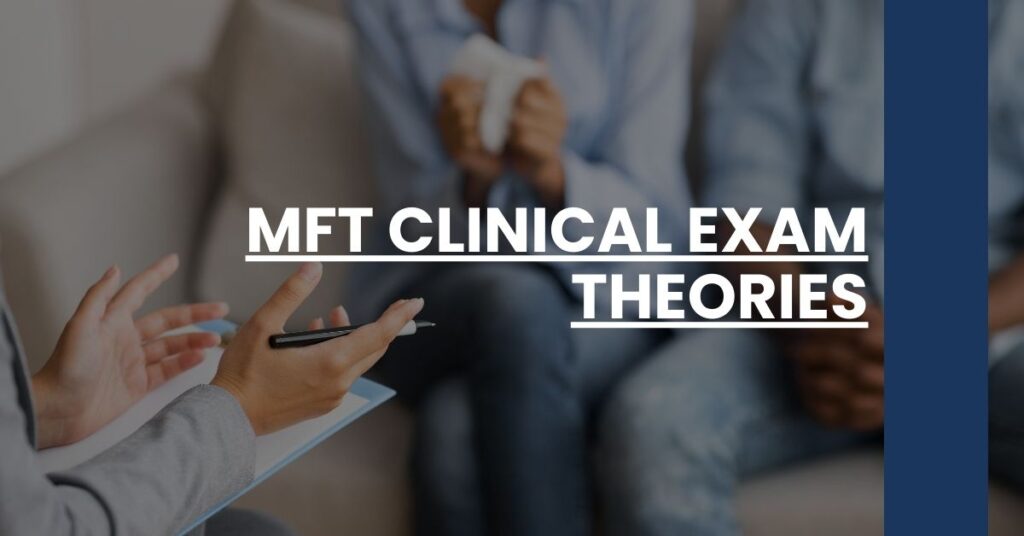MFT Clinical Exam Theories are the frameworks and approaches that guide marriage and family therapists in their practice, and understanding these is key to passing the MFT Clinical Exam.
The exam assesses knowledge across multiple theories, including systems, cognitive-behavioral, and attachment theories, to name a few.
To succeed, you’ll need to be adept at:
- Identifying the theory underlying a clinical scenario
- Applying integrative approaches in practice simulations
- Studying effectively to master complex theoretical concepts
Remember, a solid grasp of these theories won’t just help you excel on the exam — it will also enhance your professional practice.
- Understanding the MFT Clinical Exam
- Foundational Theories Tested in the MFT Clinical Exam
- The Significance of Systems Theory in MFT
- Application of Theories in Clinical Scenarios
- Integrative Approaches in MFT Clinical Practice
- Preparing for Theory Questions in the MFT Exam
- Common Pitfalls and Misconceptions About Theories in the MFT Exam
- Resources and Study Materials for Mastering MFT Theories
- Conclusion: The Path to MFT Clinical Exam Success
Understanding the MFT Clinical Exam
When you embark on a career as a marriage and family therapist, the MFT Clinical Exam represents a pivotal milestone on your professional journey. It’s both a testament to your comprehensive understanding of therapeutic modalities and your passport to licensure. The exam is designed to assess your grasp on a plethora of concepts, including a host of MFT clinical exam theories that inform effective practice.
The MFT Clinical Exam doesn’t just test your ability to memorize theories; it evaluates your proficiency in applying these theories to real-world situations. This requires a deep understanding of how individual, couple, and family dynamics intersect within various therapeutic contexts. For instance, you may be presented with case vignettes that challenge you to apply systems theory to analyze and formulate treatment strategies. Your preparedness to think critically and integrate multiple theoretical frameworks will serve you well in translating what you’ve learned into actionable therapeutic interventions.
Foundational Theories Tested in the MFT Clinical Exam
When preparing for the MFT Clinical Exam, you’ll need to dive into the foundational theories that serve as the underpinnings of marital and family therapy. Here are some of the central theories you can expect to encounter:
- Systems Theory: A cornerstone of MFT, systems theory posits that individuals cannot be fully understood in isolation from their family units.
- Attachment Theory: This theory examines the nature of the emotional bonds between people, particularly between parents and children.
- Psychoanalytic Theory: While less commonly applied in MFT practices, it’s crucial to understand how it addresses unconscious drives and conflicts.
- Cognitive-Behavioral Therapy (CBT): Often integrated into family therapy, CBT focuses on the relationships between thoughts, feelings, and behaviors.
- Solution-Focused Brief Therapy: This approach prioritizes developing solutions rather than dissecting problems.
- Narrative Therapy: Narrative therapy emphasizes the stories people construct about their lives and experiences.
Assimilating these theories into your professional repertoire is not merely a matter of academic exercise. It signifies your readiness to tackle complex familial interplay with a well-stocked toolkit of therapeutic approaches. To deepen your understanding of these foundational theories, consider exploring resources like emotionally focused therapy or examining Carl Rogers’ humanistic approach to therapy.
The Significance of Systems Theory in MFT
As you prep for the exam, give particular attention to systems theory—an MFT mainstay. Systems theory revolutionized the field of therapy, and understanding its intricacies is key to your success, both on the exam and in practice. Your ability to conceptualize individuals within their relational contexts, to see how patterns of behavior are maintained in systems, is invaluable. Grasping this interconnectedness helps you comprehend the ripple effects of change within a family.
Many case scenarios you’ll encounter in the exam are soaked in systems language. You’ll need to demonstrate aptitude in not just recognizing systemic factors but also in leveraging this understanding to inform your interventions. Consider enhancing your systems theory mastery by utilizing resources that provide detailed insights into its various nuances. For detailed explanations on thinking systemically, the Therapist Development Center offers guidance that can help refine your approach.
Application of Theories in Clinical Scenarios
What sets the MFT Clinical Exam apart is its emphasis on the practical application of theoretical knowledge. Expect to encounter clinical scenarios that resemble the complex tapestry of real-life practice. In these vignettes, the theories you’ve spent countless hours studying come to life. You’ll need to identify which theory best fits the scenario’s context and then make informed choices about therapeutic interventions. It’s a dance of knowledge and application, and you’re the choreographer stitching together deft movements to create a seamless flow.
Consider a vignette featuring a couple stuck in conflict. You might draw on Gottman’s methods to facilitate effective communication, or utilize elements of narrative therapy to help the couple re-author their story. Each scenario unfolds as a test of how well you can translate theory into practice.
Picture this: you’re provided with a case study of a teenager acting out in school. To approach this, you’ll need to not only analyze the behavior in isolation but examine the wider family system at play. Is the rebellion a result of family stresses, some unspoken relational turbulence? Here, the exam is not just asking what you know about family dynamics; it’s challenging you to use that knowledge to dissect and address problems.
Approaching the scenarios in the MFT Clinical Exam isn’t solely about identifying a problem and applying a theory-based solution. It’s about discerning the nuanced interplay of theories and the unique tapestry of each familial context. It requires a delicate balance of intuition and academic knowledge, a blend of art and science, that characterizes the very best of marriage and family therapy.
In the next section, we’ll explore how integrating these theoretical frameworks into a cohesive approach mirrors the real-world complexities of MFT clinical practice.
Integrative Approaches in MFT Clinical Practice
In the MFT Clinical Exam, and indeed in practice, the most potent approach often involves an integration of theories rather than adherence to just one. As you prepare, remember that your role is akin to that of an architect, drawing on a diverse array of tools and perspectives to construct a unique therapeutic intervention for each client system you encounter. Within the exam, you’ll need to demonstrate flexibility in applying a combination of theories to develop a tailored approach for the hypothetical families and couples you’re presented with.
Suppose you’re working with a family struggling with the impact of addiction. An integrative approach might involve employing aspects of behavioral therapies to manage the addictive behaviors, while also using emotion-focused therapy to repair and rebuild the emotional bonds strained by addiction. The knowledge and skillset you showcase when intertwining such theories exemplify the level of acumen required for success on the exam.
Embrace the complexity and diversity that come with holistic or integrative therapy, considering how various theories resonate and overlap with one another. Northwestern offers insightful perspectives on how to apply these integrative approaches in therapy, which could be directly beneficial for your exam prep (Five Counseling Theories and Approaches). Your challenge is to weave these theories into a cohesive narrative that showcases your ability to address the multifaceted nature of human relationships.
Preparing for Theory Questions in the MFT Exam
As you delve into study sessions for the theoretical portion of the MFT Clinical Exam, there’s an art to balancing depth and breadth of knowledge. Your mission is to not just recognize and recall mft clinical exam theories but to understand them so well that you can apply them intuitively.
Consider adopting a strategic approach to your exam preparation:
- Study Relationally: Understand the interplay between theories. For instance, how might Bowen’s concept of differentiation dovetail with Minuchin’s structural family therapy?
- Reflect on Practice: After each practice question, take a moment to reflect on why a particular theoretical application was the correct answer.
- Use Practice Exams Wisely: Gauge your theory comprehension with practice exams, focusing most intensely on areas where you have difficulty (MFT Practice Test).
When confronting challenging theoretical constructs, create mind maps that link different theories to specific types of clinical scenarios. This visual approach can crystallize how theories translate into practice. Integrating a varied study schedule with a mix of reading materials, practice tests, and reflective exercises can reinforce your knowledge and build confidence.
Common Pitfalls and Misconceptions About Theories in the MFT Exam
Even the most diligent students can stumble over common pitfalls and misconceptions regarding the application of theories within the MFT Clinical Exam. Here are some you’ll want to navigate carefully:
- Broad Application Missteps: Remember that not every theory fits every scenario. Be discerning in matching the right theory to the right clinical context.
- Over-Complication: Sometimes the most straightforward theory provides the clear path to understanding a scenario. Resist the impulse to overthink.
- Misjudging Key Concepts: Make certain you understand the key tenets of each theory to avoid misconceptions. For instance, don’t confuse attachment theory‘s focus on emotional bonds with systemic theory’s emphasis on family dynamics.
By staying vigilant against such errors and continuously testing and re-testing your understanding, you’ll sharpen your theoretical acumen, steering clear of potential missteps.
Resources and Study Materials for Mastering MFT Theories
Building a sturdy foundation in MFT clinical exam theories is akin to assembling a toolkit for success. It’s vital to choose resources that not only cover a breadth of material but also delve deep into the nuances of each theory.
As you compile your study library, consider these types of resources:
- Academic Texts: They are the bedrock of your study plan, providing comprehensive overviews of essential theories.
- Online Courses and Workshops: These can offer interactive and engaging learning experiences.
- Flashcards: Great for quick recall of key theory points.
- Peer Study Groups: Engage in discussions to deepen your theoretical understanding.
The key is to curate a blend of materials that caters to a variety of learning styles and preferences. Mix reliable texts with interactive digital resources to diversify your study approach. Although the research for this article did not yield specific recommendations, exploring well-reviewed MFT study guides and practice exams can be immensely beneficial.
Conclusion: The Path to MFT Clinical Exam Success
Your journey towards excelling in the MFT Clinical Exam is a marathon, not a sprint. Navigating the vast landscape of mft clinical exam theories demands patience, dedication, and strategic study habits. Embracing an integrative viewpoint, understanding common misconceptions, and utilizing a dynamic array of resources are quintessential for success.
Remember, your pursuit of mastering the theoretical constructs of MFT isn’t just about passing an exam. It’s a pathway to becoming a more effective therapist, capable of orchestrating change in the intricate dance of human relationships. So, as you buckle down and deepen your understanding of the profound theories that guide this practice, see each study session as a step towards not only professional licensure but professional distinction. Your future clients will benefit from the depth and breadth of your expertise, and that begins here, with the thoughtful preparation for your MFT Clinical Exam.
Explore fundamental MFT Clinical Exam theories for an effective study guide, reinforcing your understanding and application in therapy practice.

